Pastoral Response to HIV/AIDS
VerifiedAdded on 2022/11/19
|15
|4071
|297
AI Summary
This document discusses the pastoral response to HIV/AIDS and how to challenge stigma and discrimination in the church. It also covers the importance of promoting prevention and providing care to those affected, as well as how the church can be a prophetic voice. The implications of Imago Dei for HIV/AIDS are also explored.
Contribute Materials
Your contribution can guide someone’s learning journey. Share your
documents today.
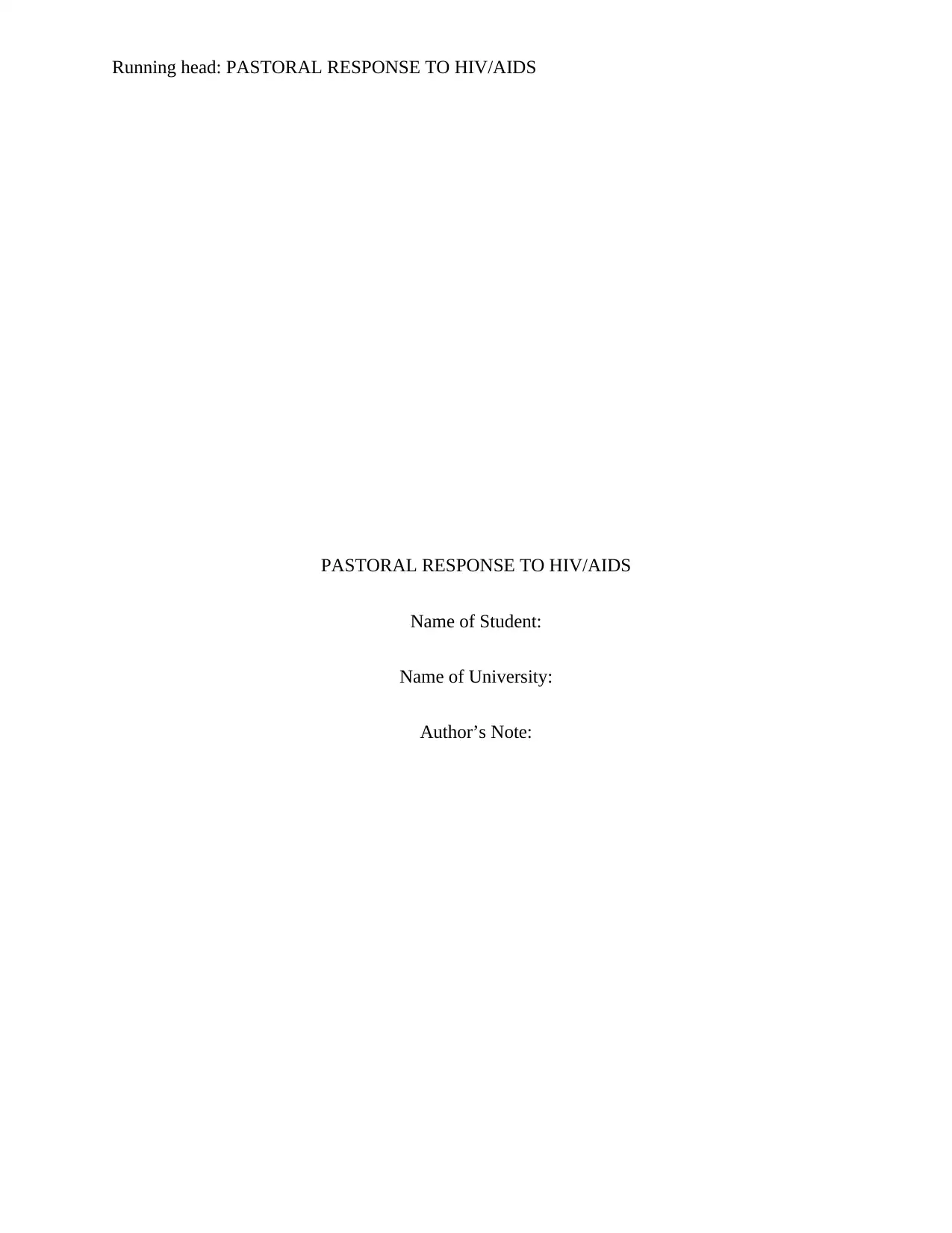
Running head: PASTORAL RESPONSE TO HIV/AIDS
PASTORAL RESPONSE TO HIV/AIDS
Name of Student:
Name of University:
Author’s Note:
PASTORAL RESPONSE TO HIV/AIDS
Name of Student:
Name of University:
Author’s Note:
Secure Best Marks with AI Grader
Need help grading? Try our AI Grader for instant feedback on your assignments.
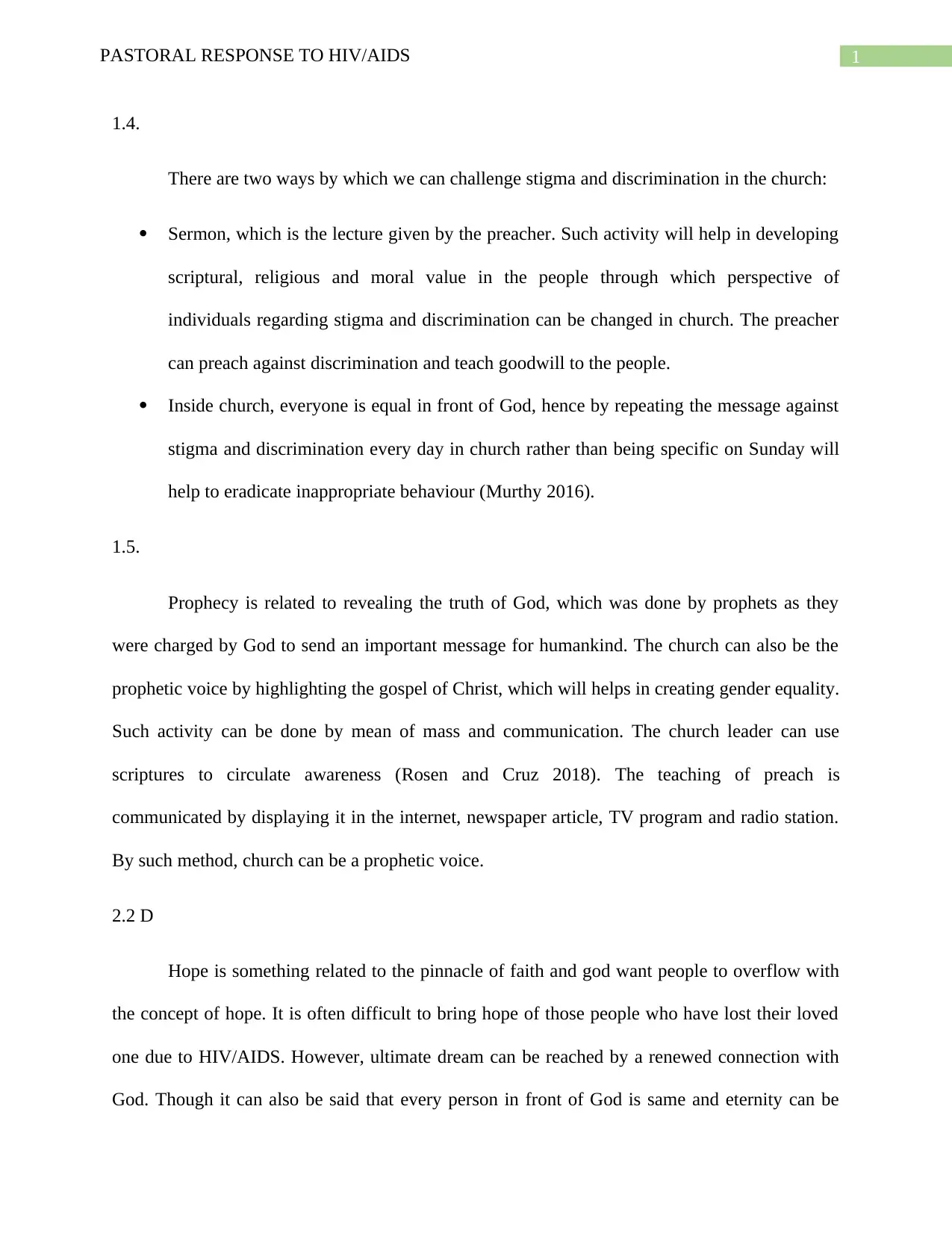
1PASTORAL RESPONSE TO HIV/AIDS
1.4.
There are two ways by which we can challenge stigma and discrimination in the church:
Sermon, which is the lecture given by the preacher. Such activity will help in developing
scriptural, religious and moral value in the people through which perspective of
individuals regarding stigma and discrimination can be changed in church. The preacher
can preach against discrimination and teach goodwill to the people.
Inside church, everyone is equal in front of God, hence by repeating the message against
stigma and discrimination every day in church rather than being specific on Sunday will
help to eradicate inappropriate behaviour (Murthy 2016).
1.5.
Prophecy is related to revealing the truth of God, which was done by prophets as they
were charged by God to send an important message for humankind. The church can also be the
prophetic voice by highlighting the gospel of Christ, which will helps in creating gender equality.
Such activity can be done by mean of mass and communication. The church leader can use
scriptures to circulate awareness (Rosen and Cruz 2018). The teaching of preach is
communicated by displaying it in the internet, newspaper article, TV program and radio station.
By such method, church can be a prophetic voice.
2.2 D
Hope is something related to the pinnacle of faith and god want people to overflow with
the concept of hope. It is often difficult to bring hope of those people who have lost their loved
one due to HIV/AIDS. However, ultimate dream can be reached by a renewed connection with
God. Though it can also be said that every person in front of God is same and eternity can be
1.4.
There are two ways by which we can challenge stigma and discrimination in the church:
Sermon, which is the lecture given by the preacher. Such activity will help in developing
scriptural, religious and moral value in the people through which perspective of
individuals regarding stigma and discrimination can be changed in church. The preacher
can preach against discrimination and teach goodwill to the people.
Inside church, everyone is equal in front of God, hence by repeating the message against
stigma and discrimination every day in church rather than being specific on Sunday will
help to eradicate inappropriate behaviour (Murthy 2016).
1.5.
Prophecy is related to revealing the truth of God, which was done by prophets as they
were charged by God to send an important message for humankind. The church can also be the
prophetic voice by highlighting the gospel of Christ, which will helps in creating gender equality.
Such activity can be done by mean of mass and communication. The church leader can use
scriptures to circulate awareness (Rosen and Cruz 2018). The teaching of preach is
communicated by displaying it in the internet, newspaper article, TV program and radio station.
By such method, church can be a prophetic voice.
2.2 D
Hope is something related to the pinnacle of faith and god want people to overflow with
the concept of hope. It is often difficult to bring hope of those people who have lost their loved
one due to HIV/AIDS. However, ultimate dream can be reached by a renewed connection with
God. Though it can also be said that every person in front of God is same and eternity can be

2PASTORAL RESPONSE TO HIV/AIDS
shared with God (Okyere-Manu 2016). Therefore, the people who are affected by HIV/AIDS
need to create their strong relationship with God by keeping immense faith in Jesus. Not every
person will be able to follow it, hence being with the people in their harsh time is itself a conduit
for hope.
2.2 E.
In the midst of tragedy, God does not want anything more from their creation, which is
beyond our limit. God only expects his follower to show compassion, sympathy and concern to
those individuals who are affected by HIV/AIDS. He wants his followers to show care and love
to our neighbours in the same way they do to themselves (Hill 2017). He also wants to give
special consideration to needy people who are sick, widow, HIV/AIDS infected person and
orphan people.
2.3
A. As per the teaching of God, we have to give adequate care and concern to the needy
people. Such awareness can be achieved by mean of communicating the teaching to
people by the action of church and priest. However, many of the church has not given any
responsibility for the first 20 years, and some who responded spoke with silence, stigma
and discrimination. Such activity has resulted in a high rate of discrimination and stigma.
Church has avoided the people who needed help, and as an outcome of it many of the
people have shunned themselves in getting into the test. The main reason for such is the
fear of people that they will be turned away if they are diagnosed with HIV/AIDS
(Gebreyesus et al. 2019). Hence, the virus gets spread undetected into the community.
The leader of the church is inclined to discuss HIV/AIDS as it is more comfortable to
shared with God (Okyere-Manu 2016). Therefore, the people who are affected by HIV/AIDS
need to create their strong relationship with God by keeping immense faith in Jesus. Not every
person will be able to follow it, hence being with the people in their harsh time is itself a conduit
for hope.
2.2 E.
In the midst of tragedy, God does not want anything more from their creation, which is
beyond our limit. God only expects his follower to show compassion, sympathy and concern to
those individuals who are affected by HIV/AIDS. He wants his followers to show care and love
to our neighbours in the same way they do to themselves (Hill 2017). He also wants to give
special consideration to needy people who are sick, widow, HIV/AIDS infected person and
orphan people.
2.3
A. As per the teaching of God, we have to give adequate care and concern to the needy
people. Such awareness can be achieved by mean of communicating the teaching to
people by the action of church and priest. However, many of the church has not given any
responsibility for the first 20 years, and some who responded spoke with silence, stigma
and discrimination. Such activity has resulted in a high rate of discrimination and stigma.
Church has avoided the people who needed help, and as an outcome of it many of the
people have shunned themselves in getting into the test. The main reason for such is the
fear of people that they will be turned away if they are diagnosed with HIV/AIDS
(Gebreyesus et al. 2019). Hence, the virus gets spread undetected into the community.
The leader of the church is inclined to discuss HIV/AIDS as it is more comfortable to
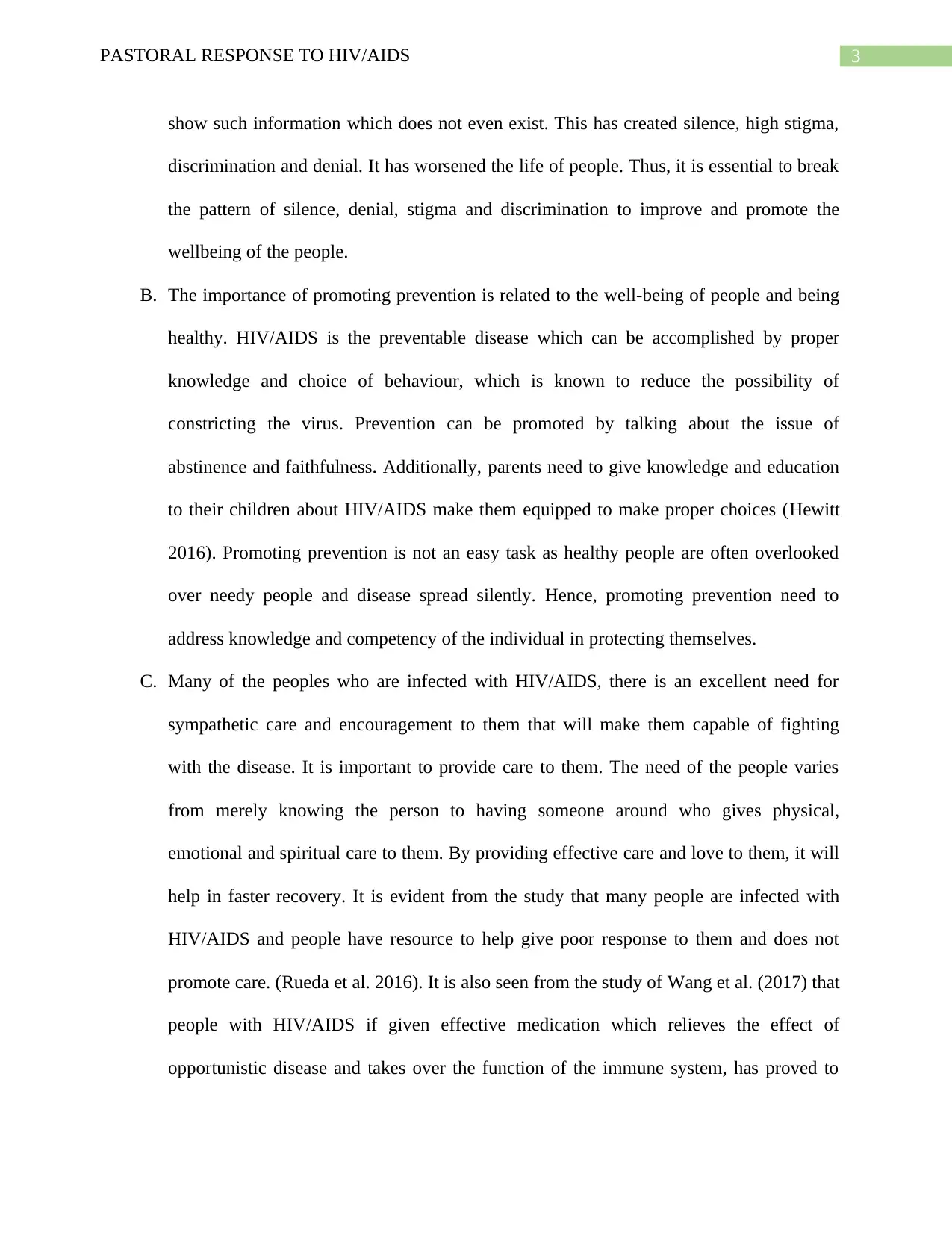
3PASTORAL RESPONSE TO HIV/AIDS
show such information which does not even exist. This has created silence, high stigma,
discrimination and denial. It has worsened the life of people. Thus, it is essential to break
the pattern of silence, denial, stigma and discrimination to improve and promote the
wellbeing of the people.
B. The importance of promoting prevention is related to the well-being of people and being
healthy. HIV/AIDS is the preventable disease which can be accomplished by proper
knowledge and choice of behaviour, which is known to reduce the possibility of
constricting the virus. Prevention can be promoted by talking about the issue of
abstinence and faithfulness. Additionally, parents need to give knowledge and education
to their children about HIV/AIDS make them equipped to make proper choices (Hewitt
2016). Promoting prevention is not an easy task as healthy people are often overlooked
over needy people and disease spread silently. Hence, promoting prevention need to
address knowledge and competency of the individual in protecting themselves.
C. Many of the peoples who are infected with HIV/AIDS, there is an excellent need for
sympathetic care and encouragement to them that will make them capable of fighting
with the disease. It is important to provide care to them. The need of the people varies
from merely knowing the person to having someone around who gives physical,
emotional and spiritual care to them. By providing effective care and love to them, it will
help in faster recovery. It is evident from the study that many people are infected with
HIV/AIDS and people have resource to help give poor response to them and does not
promote care. (Rueda et al. 2016). It is also seen from the study of Wang et al. (2017) that
people with HIV/AIDS if given effective medication which relieves the effect of
opportunistic disease and takes over the function of the immune system, has proved to
show such information which does not even exist. This has created silence, high stigma,
discrimination and denial. It has worsened the life of people. Thus, it is essential to break
the pattern of silence, denial, stigma and discrimination to improve and promote the
wellbeing of the people.
B. The importance of promoting prevention is related to the well-being of people and being
healthy. HIV/AIDS is the preventable disease which can be accomplished by proper
knowledge and choice of behaviour, which is known to reduce the possibility of
constricting the virus. Prevention can be promoted by talking about the issue of
abstinence and faithfulness. Additionally, parents need to give knowledge and education
to their children about HIV/AIDS make them equipped to make proper choices (Hewitt
2016). Promoting prevention is not an easy task as healthy people are often overlooked
over needy people and disease spread silently. Hence, promoting prevention need to
address knowledge and competency of the individual in protecting themselves.
C. Many of the peoples who are infected with HIV/AIDS, there is an excellent need for
sympathetic care and encouragement to them that will make them capable of fighting
with the disease. It is important to provide care to them. The need of the people varies
from merely knowing the person to having someone around who gives physical,
emotional and spiritual care to them. By providing effective care and love to them, it will
help in faster recovery. It is evident from the study that many people are infected with
HIV/AIDS and people have resource to help give poor response to them and does not
promote care. (Rueda et al. 2016). It is also seen from the study of Wang et al. (2017) that
people with HIV/AIDS if given effective medication which relieves the effect of
opportunistic disease and takes over the function of the immune system, has proved to
Secure Best Marks with AI Grader
Need help grading? Try our AI Grader for instant feedback on your assignments.
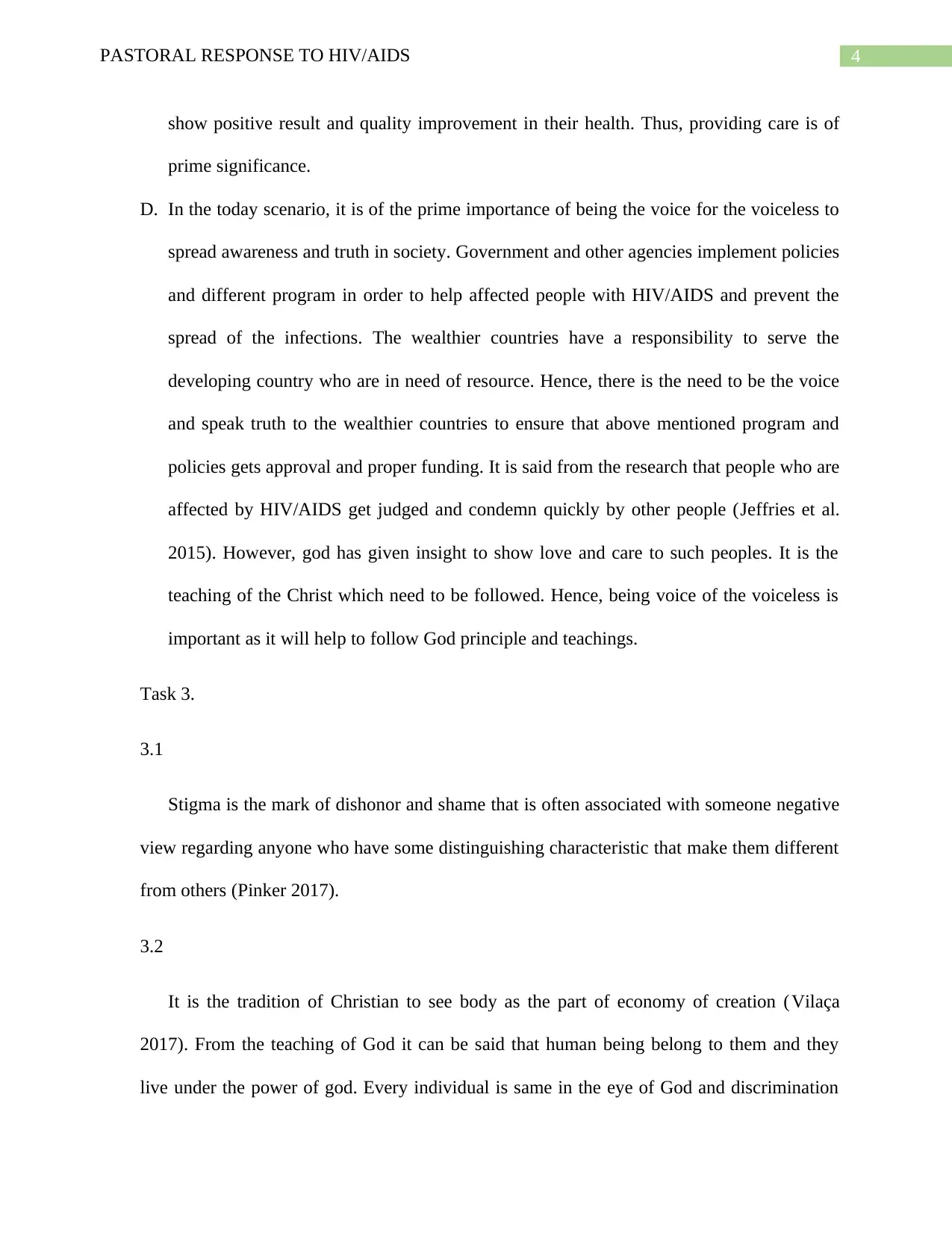
4PASTORAL RESPONSE TO HIV/AIDS
show positive result and quality improvement in their health. Thus, providing care is of
prime significance.
D. In the today scenario, it is of the prime importance of being the voice for the voiceless to
spread awareness and truth in society. Government and other agencies implement policies
and different program in order to help affected people with HIV/AIDS and prevent the
spread of the infections. The wealthier countries have a responsibility to serve the
developing country who are in need of resource. Hence, there is the need to be the voice
and speak truth to the wealthier countries to ensure that above mentioned program and
policies gets approval and proper funding. It is said from the research that people who are
affected by HIV/AIDS get judged and condemn quickly by other people (Jeffries et al.
2015). However, god has given insight to show love and care to such peoples. It is the
teaching of the Christ which need to be followed. Hence, being voice of the voiceless is
important as it will help to follow God principle and teachings.
Task 3.
3.1
Stigma is the mark of dishonor and shame that is often associated with someone negative
view regarding anyone who have some distinguishing characteristic that make them different
from others (Pinker 2017).
3.2
It is the tradition of Christian to see body as the part of economy of creation (Vilaça
2017). From the teaching of God it can be said that human being belong to them and they
live under the power of god. Every individual is same in the eye of God and discrimination
show positive result and quality improvement in their health. Thus, providing care is of
prime significance.
D. In the today scenario, it is of the prime importance of being the voice for the voiceless to
spread awareness and truth in society. Government and other agencies implement policies
and different program in order to help affected people with HIV/AIDS and prevent the
spread of the infections. The wealthier countries have a responsibility to serve the
developing country who are in need of resource. Hence, there is the need to be the voice
and speak truth to the wealthier countries to ensure that above mentioned program and
policies gets approval and proper funding. It is said from the research that people who are
affected by HIV/AIDS get judged and condemn quickly by other people (Jeffries et al.
2015). However, god has given insight to show love and care to such peoples. It is the
teaching of the Christ which need to be followed. Hence, being voice of the voiceless is
important as it will help to follow God principle and teachings.
Task 3.
3.1
Stigma is the mark of dishonor and shame that is often associated with someone negative
view regarding anyone who have some distinguishing characteristic that make them different
from others (Pinker 2017).
3.2
It is the tradition of Christian to see body as the part of economy of creation (Vilaça
2017). From the teaching of God it can be said that human being belong to them and they
live under the power of god. Every individual is same in the eye of God and discrimination
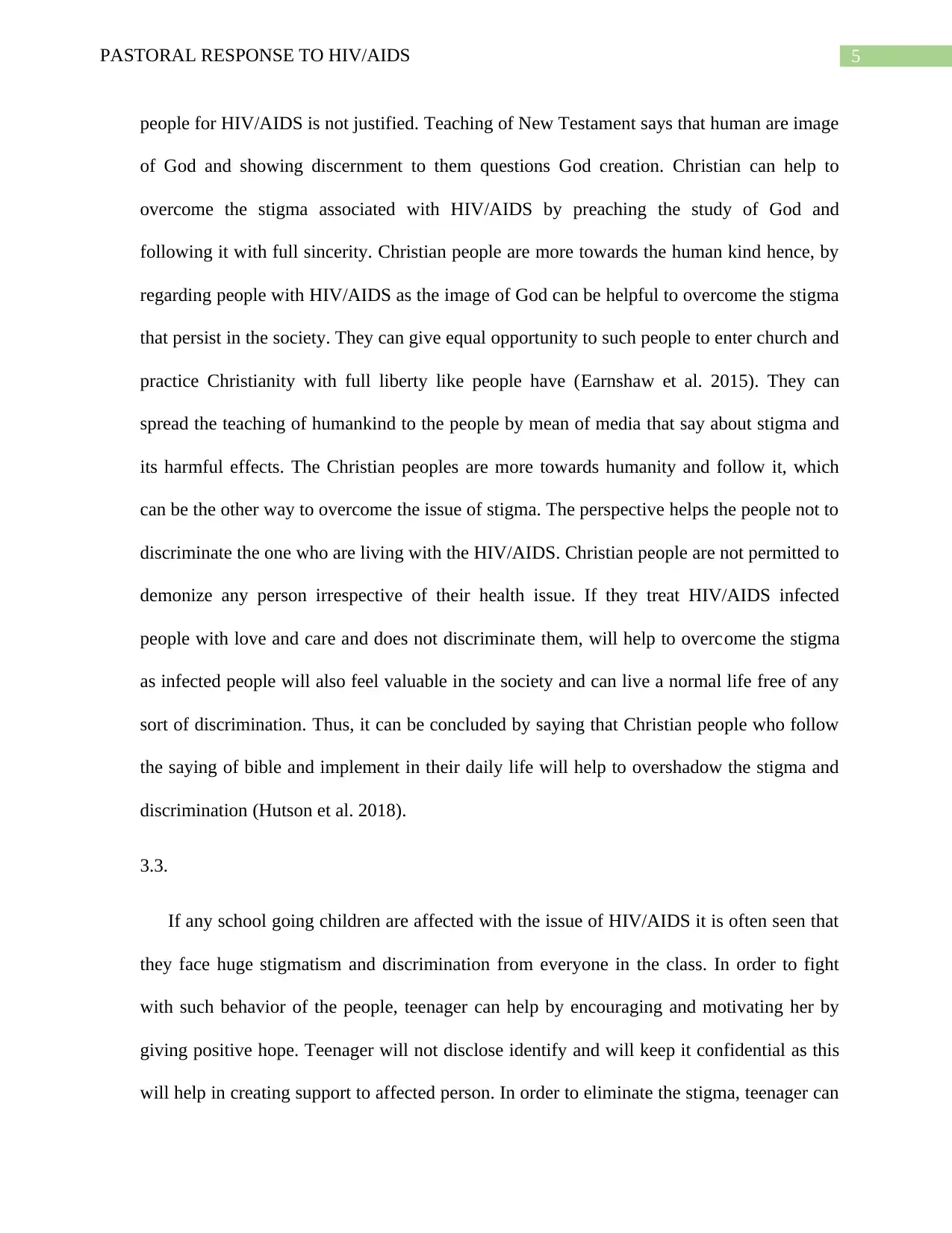
5PASTORAL RESPONSE TO HIV/AIDS
people for HIV/AIDS is not justified. Teaching of New Testament says that human are image
of God and showing discernment to them questions God creation. Christian can help to
overcome the stigma associated with HIV/AIDS by preaching the study of God and
following it with full sincerity. Christian people are more towards the human kind hence, by
regarding people with HIV/AIDS as the image of God can be helpful to overcome the stigma
that persist in the society. They can give equal opportunity to such people to enter church and
practice Christianity with full liberty like people have (Earnshaw et al. 2015). They can
spread the teaching of humankind to the people by mean of media that say about stigma and
its harmful effects. The Christian peoples are more towards humanity and follow it, which
can be the other way to overcome the issue of stigma. The perspective helps the people not to
discriminate the one who are living with the HIV/AIDS. Christian people are not permitted to
demonize any person irrespective of their health issue. If they treat HIV/AIDS infected
people with love and care and does not discriminate them, will help to overcome the stigma
as infected people will also feel valuable in the society and can live a normal life free of any
sort of discrimination. Thus, it can be concluded by saying that Christian people who follow
the saying of bible and implement in their daily life will help to overshadow the stigma and
discrimination (Hutson et al. 2018).
3.3.
If any school going children are affected with the issue of HIV/AIDS it is often seen that
they face huge stigmatism and discrimination from everyone in the class. In order to fight
with such behavior of the people, teenager can help by encouraging and motivating her by
giving positive hope. Teenager will not disclose identify and will keep it confidential as this
will help in creating support to affected person. In order to eliminate the stigma, teenager can
people for HIV/AIDS is not justified. Teaching of New Testament says that human are image
of God and showing discernment to them questions God creation. Christian can help to
overcome the stigma associated with HIV/AIDS by preaching the study of God and
following it with full sincerity. Christian people are more towards the human kind hence, by
regarding people with HIV/AIDS as the image of God can be helpful to overcome the stigma
that persist in the society. They can give equal opportunity to such people to enter church and
practice Christianity with full liberty like people have (Earnshaw et al. 2015). They can
spread the teaching of humankind to the people by mean of media that say about stigma and
its harmful effects. The Christian peoples are more towards humanity and follow it, which
can be the other way to overcome the issue of stigma. The perspective helps the people not to
discriminate the one who are living with the HIV/AIDS. Christian people are not permitted to
demonize any person irrespective of their health issue. If they treat HIV/AIDS infected
people with love and care and does not discriminate them, will help to overcome the stigma
as infected people will also feel valuable in the society and can live a normal life free of any
sort of discrimination. Thus, it can be concluded by saying that Christian people who follow
the saying of bible and implement in their daily life will help to overshadow the stigma and
discrimination (Hutson et al. 2018).
3.3.
If any school going children are affected with the issue of HIV/AIDS it is often seen that
they face huge stigmatism and discrimination from everyone in the class. In order to fight
with such behavior of the people, teenager can help by encouraging and motivating her by
giving positive hope. Teenager will not disclose identify and will keep it confidential as this
will help in creating support to affected person. In order to eliminate the stigma, teenager can

6PASTORAL RESPONSE TO HIV/AIDS
spread awareness about the disease and will request the people to not show any
discrimination as this create inequality and discrimination (McAteer et al. 2016). Being
aware about the behavior of people and breaking the silence will help to remove the stigma
and discrimination. The most practical way which teenager can remove the stigma is by
educating people about the disease and humanity.
Task 4.
Imago dei and its implication for HIV/AIDS:
Respect- Giving respect for the image of God to the women is something which cannot
be ignored and being male is not the term for being human. The thing that need to be
noted is meaning of human and humanity. To restore image of God in terms of respect of
female, there is the need to overcome the ill thinking about the female body. The female
is not something who is only known to be give birth as this seem to be more harmful for
her to summit herself to sexual procreation even if his partner is HIV positive. Body of
female is made in the image of God and need to be respected (Kang 2015).
Dignity- Imago Dei tells about the human dignity and says that each of the person are
dignified by not just being a human being, but because they are created in the image of
God. It has treated every individual sacred apart from being religiously different. Hence,
it can be said that if the human is regarded as scared and the person is also gracious.
Body is scared- In the current culture of society that are affected with HIV/AIDS virus
and the theory which speak that human body is scared give idea that virus cannot
eradicate the sense of self and dignity. Thus, it is the responsibility of the church to treat
every human as special and give them love, care and protection in order to sustain dignity
of human when they become affected by the disease. The infected person do not have to
spread awareness about the disease and will request the people to not show any
discrimination as this create inequality and discrimination (McAteer et al. 2016). Being
aware about the behavior of people and breaking the silence will help to remove the stigma
and discrimination. The most practical way which teenager can remove the stigma is by
educating people about the disease and humanity.
Task 4.
Imago dei and its implication for HIV/AIDS:
Respect- Giving respect for the image of God to the women is something which cannot
be ignored and being male is not the term for being human. The thing that need to be
noted is meaning of human and humanity. To restore image of God in terms of respect of
female, there is the need to overcome the ill thinking about the female body. The female
is not something who is only known to be give birth as this seem to be more harmful for
her to summit herself to sexual procreation even if his partner is HIV positive. Body of
female is made in the image of God and need to be respected (Kang 2015).
Dignity- Imago Dei tells about the human dignity and says that each of the person are
dignified by not just being a human being, but because they are created in the image of
God. It has treated every individual sacred apart from being religiously different. Hence,
it can be said that if the human is regarded as scared and the person is also gracious.
Body is scared- In the current culture of society that are affected with HIV/AIDS virus
and the theory which speak that human body is scared give idea that virus cannot
eradicate the sense of self and dignity. Thus, it is the responsibility of the church to treat
every human as special and give them love, care and protection in order to sustain dignity
of human when they become affected by the disease. The infected person do not have to
Paraphrase This Document
Need a fresh take? Get an instant paraphrase of this document with our AI Paraphraser
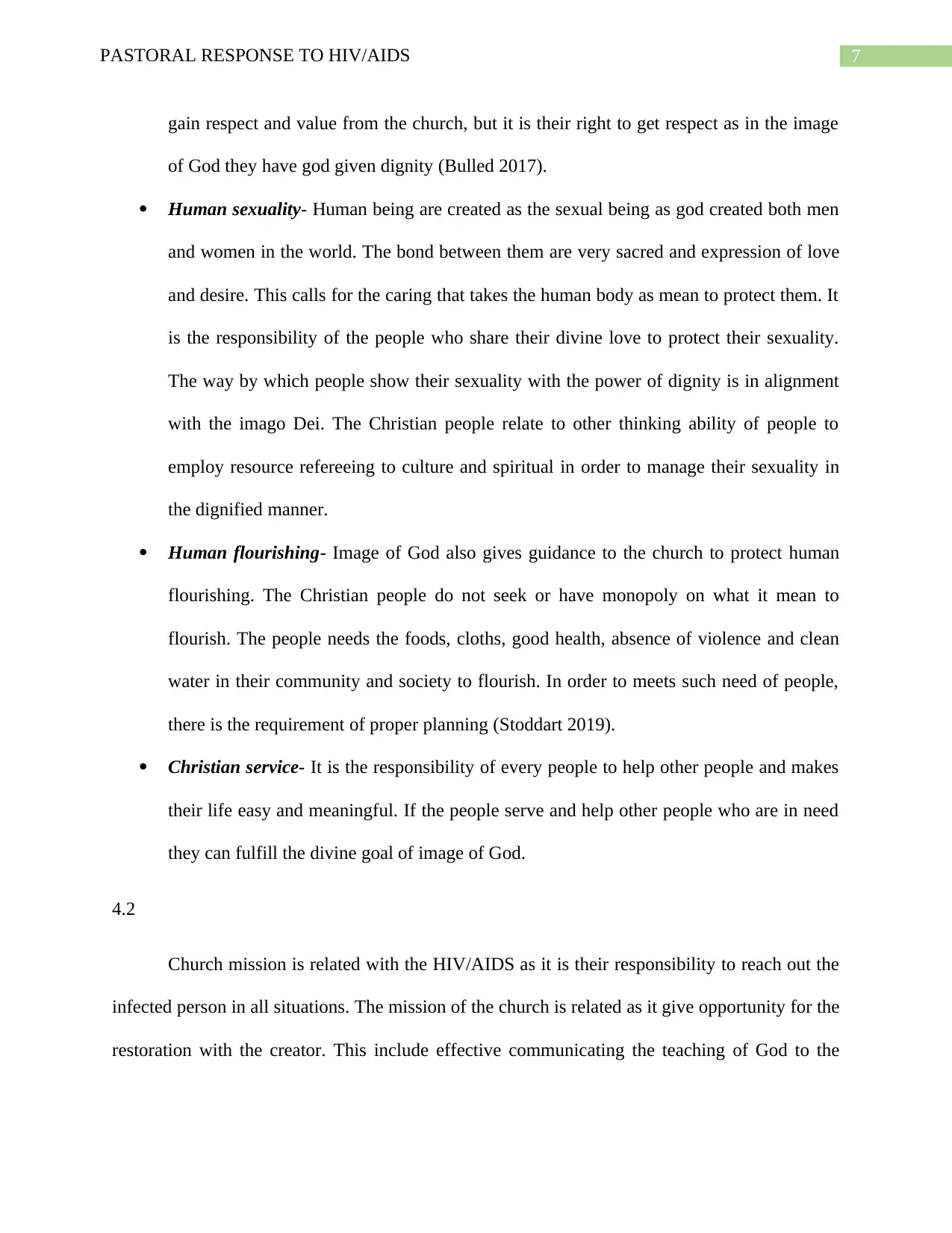
7PASTORAL RESPONSE TO HIV/AIDS
gain respect and value from the church, but it is their right to get respect as in the image
of God they have god given dignity (Bulled 2017).
Human sexuality- Human being are created as the sexual being as god created both men
and women in the world. The bond between them are very sacred and expression of love
and desire. This calls for the caring that takes the human body as mean to protect them. It
is the responsibility of the people who share their divine love to protect their sexuality.
The way by which people show their sexuality with the power of dignity is in alignment
with the imago Dei. The Christian people relate to other thinking ability of people to
employ resource refereeing to culture and spiritual in order to manage their sexuality in
the dignified manner.
Human flourishing- Image of God also gives guidance to the church to protect human
flourishing. The Christian people do not seek or have monopoly on what it mean to
flourish. The people needs the foods, cloths, good health, absence of violence and clean
water in their community and society to flourish. In order to meets such need of people,
there is the requirement of proper planning (Stoddart 2019).
Christian service- It is the responsibility of every people to help other people and makes
their life easy and meaningful. If the people serve and help other people who are in need
they can fulfill the divine goal of image of God.
4.2
Church mission is related with the HIV/AIDS as it is their responsibility to reach out the
infected person in all situations. The mission of the church is related as it give opportunity for the
restoration with the creator. This include effective communicating the teaching of God to the
gain respect and value from the church, but it is their right to get respect as in the image
of God they have god given dignity (Bulled 2017).
Human sexuality- Human being are created as the sexual being as god created both men
and women in the world. The bond between them are very sacred and expression of love
and desire. This calls for the caring that takes the human body as mean to protect them. It
is the responsibility of the people who share their divine love to protect their sexuality.
The way by which people show their sexuality with the power of dignity is in alignment
with the imago Dei. The Christian people relate to other thinking ability of people to
employ resource refereeing to culture and spiritual in order to manage their sexuality in
the dignified manner.
Human flourishing- Image of God also gives guidance to the church to protect human
flourishing. The Christian people do not seek or have monopoly on what it mean to
flourish. The people needs the foods, cloths, good health, absence of violence and clean
water in their community and society to flourish. In order to meets such need of people,
there is the requirement of proper planning (Stoddart 2019).
Christian service- It is the responsibility of every people to help other people and makes
their life easy and meaningful. If the people serve and help other people who are in need
they can fulfill the divine goal of image of God.
4.2
Church mission is related with the HIV/AIDS as it is their responsibility to reach out the
infected person in all situations. The mission of the church is related as it give opportunity for the
restoration with the creator. This include effective communicating the teaching of God to the
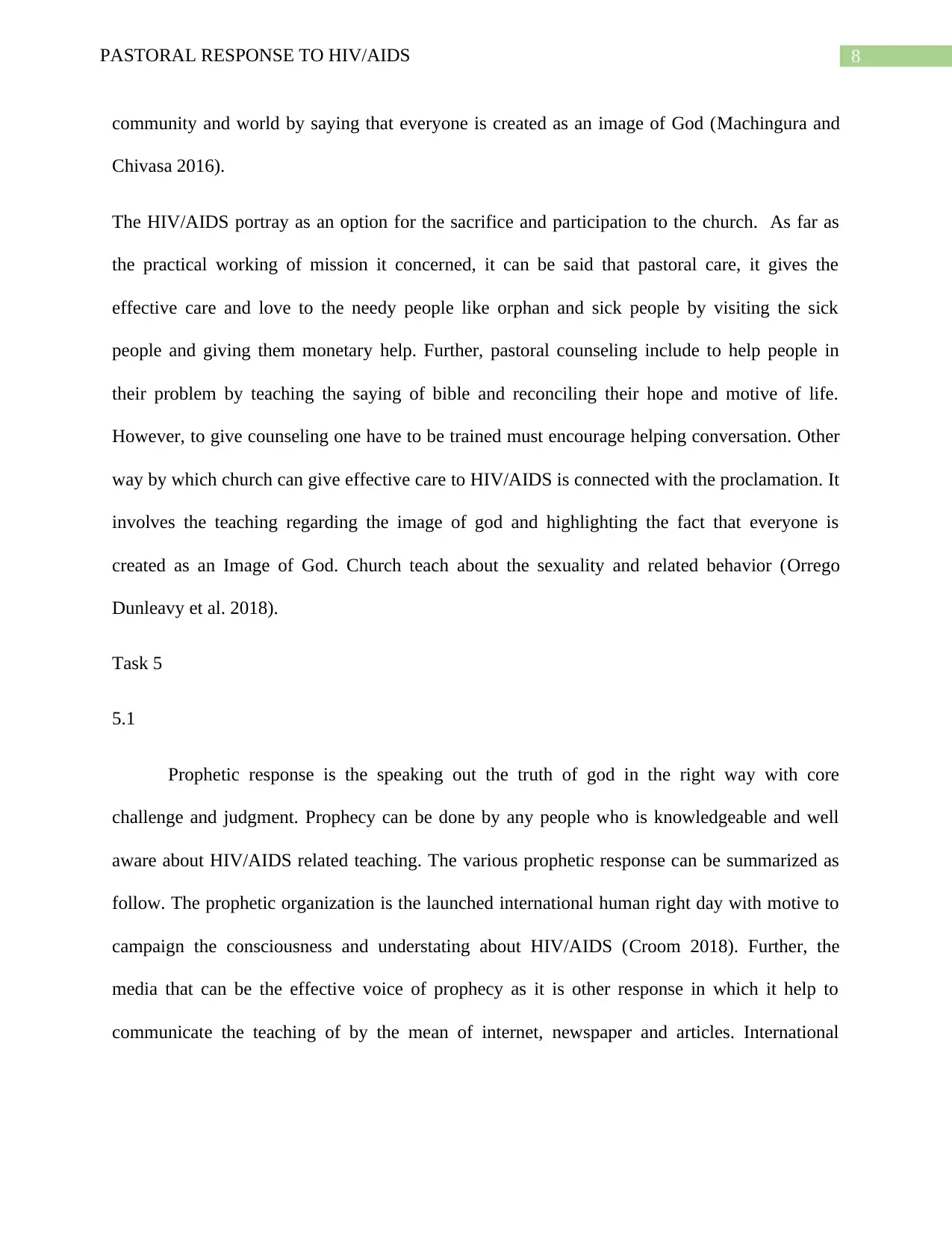
8PASTORAL RESPONSE TO HIV/AIDS
community and world by saying that everyone is created as an image of God (Machingura and
Chivasa 2016).
The HIV/AIDS portray as an option for the sacrifice and participation to the church. As far as
the practical working of mission it concerned, it can be said that pastoral care, it gives the
effective care and love to the needy people like orphan and sick people by visiting the sick
people and giving them monetary help. Further, pastoral counseling include to help people in
their problem by teaching the saying of bible and reconciling their hope and motive of life.
However, to give counseling one have to be trained must encourage helping conversation. Other
way by which church can give effective care to HIV/AIDS is connected with the proclamation. It
involves the teaching regarding the image of god and highlighting the fact that everyone is
created as an Image of God. Church teach about the sexuality and related behavior (Orrego
Dunleavy et al. 2018).
Task 5
5.1
Prophetic response is the speaking out the truth of god in the right way with core
challenge and judgment. Prophecy can be done by any people who is knowledgeable and well
aware about HIV/AIDS related teaching. The various prophetic response can be summarized as
follow. The prophetic organization is the launched international human right day with motive to
campaign the consciousness and understating about HIV/AIDS (Croom 2018). Further, the
media that can be the effective voice of prophecy as it is other response in which it help to
communicate the teaching of by the mean of internet, newspaper and articles. International
community and world by saying that everyone is created as an image of God (Machingura and
Chivasa 2016).
The HIV/AIDS portray as an option for the sacrifice and participation to the church. As far as
the practical working of mission it concerned, it can be said that pastoral care, it gives the
effective care and love to the needy people like orphan and sick people by visiting the sick
people and giving them monetary help. Further, pastoral counseling include to help people in
their problem by teaching the saying of bible and reconciling their hope and motive of life.
However, to give counseling one have to be trained must encourage helping conversation. Other
way by which church can give effective care to HIV/AIDS is connected with the proclamation. It
involves the teaching regarding the image of god and highlighting the fact that everyone is
created as an Image of God. Church teach about the sexuality and related behavior (Orrego
Dunleavy et al. 2018).
Task 5
5.1
Prophetic response is the speaking out the truth of god in the right way with core
challenge and judgment. Prophecy can be done by any people who is knowledgeable and well
aware about HIV/AIDS related teaching. The various prophetic response can be summarized as
follow. The prophetic organization is the launched international human right day with motive to
campaign the consciousness and understating about HIV/AIDS (Croom 2018). Further, the
media that can be the effective voice of prophecy as it is other response in which it help to
communicate the teaching of by the mean of internet, newspaper and articles. International
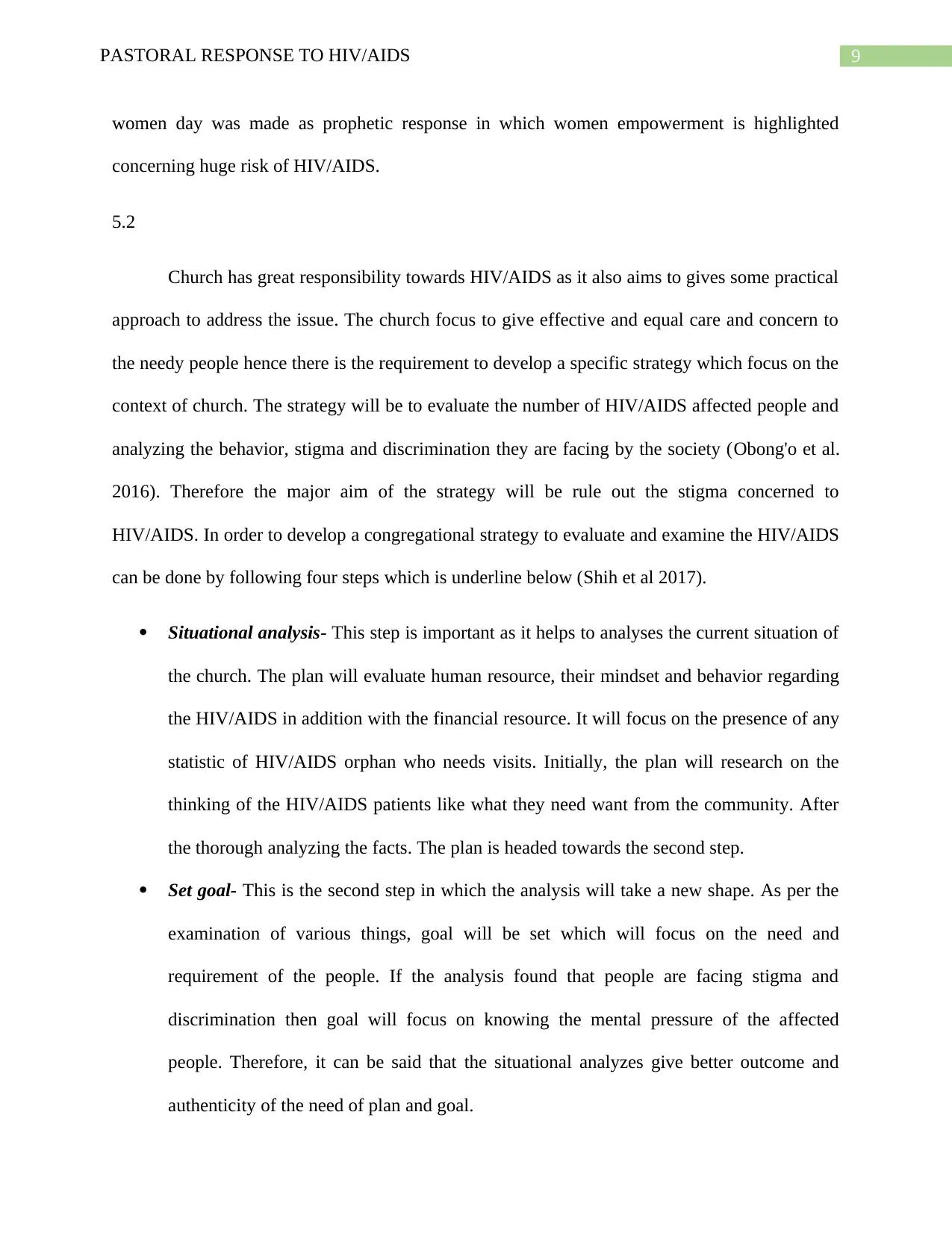
9PASTORAL RESPONSE TO HIV/AIDS
women day was made as prophetic response in which women empowerment is highlighted
concerning huge risk of HIV/AIDS.
5.2
Church has great responsibility towards HIV/AIDS as it also aims to gives some practical
approach to address the issue. The church focus to give effective and equal care and concern to
the needy people hence there is the requirement to develop a specific strategy which focus on the
context of church. The strategy will be to evaluate the number of HIV/AIDS affected people and
analyzing the behavior, stigma and discrimination they are facing by the society (Obong'o et al.
2016). Therefore the major aim of the strategy will be rule out the stigma concerned to
HIV/AIDS. In order to develop a congregational strategy to evaluate and examine the HIV/AIDS
can be done by following four steps which is underline below (Shih et al 2017).
Situational analysis- This step is important as it helps to analyses the current situation of
the church. The plan will evaluate human resource, their mindset and behavior regarding
the HIV/AIDS in addition with the financial resource. It will focus on the presence of any
statistic of HIV/AIDS orphan who needs visits. Initially, the plan will research on the
thinking of the HIV/AIDS patients like what they need want from the community. After
the thorough analyzing the facts. The plan is headed towards the second step.
Set goal- This is the second step in which the analysis will take a new shape. As per the
examination of various things, goal will be set which will focus on the need and
requirement of the people. If the analysis found that people are facing stigma and
discrimination then goal will focus on knowing the mental pressure of the affected
people. Therefore, it can be said that the situational analyzes give better outcome and
authenticity of the need of plan and goal.
women day was made as prophetic response in which women empowerment is highlighted
concerning huge risk of HIV/AIDS.
5.2
Church has great responsibility towards HIV/AIDS as it also aims to gives some practical
approach to address the issue. The church focus to give effective and equal care and concern to
the needy people hence there is the requirement to develop a specific strategy which focus on the
context of church. The strategy will be to evaluate the number of HIV/AIDS affected people and
analyzing the behavior, stigma and discrimination they are facing by the society (Obong'o et al.
2016). Therefore the major aim of the strategy will be rule out the stigma concerned to
HIV/AIDS. In order to develop a congregational strategy to evaluate and examine the HIV/AIDS
can be done by following four steps which is underline below (Shih et al 2017).
Situational analysis- This step is important as it helps to analyses the current situation of
the church. The plan will evaluate human resource, their mindset and behavior regarding
the HIV/AIDS in addition with the financial resource. It will focus on the presence of any
statistic of HIV/AIDS orphan who needs visits. Initially, the plan will research on the
thinking of the HIV/AIDS patients like what they need want from the community. After
the thorough analyzing the facts. The plan is headed towards the second step.
Set goal- This is the second step in which the analysis will take a new shape. As per the
examination of various things, goal will be set which will focus on the need and
requirement of the people. If the analysis found that people are facing stigma and
discrimination then goal will focus on knowing the mental pressure of the affected
people. Therefore, it can be said that the situational analyzes give better outcome and
authenticity of the need of plan and goal.
Secure Best Marks with AI Grader
Need help grading? Try our AI Grader for instant feedback on your assignments.
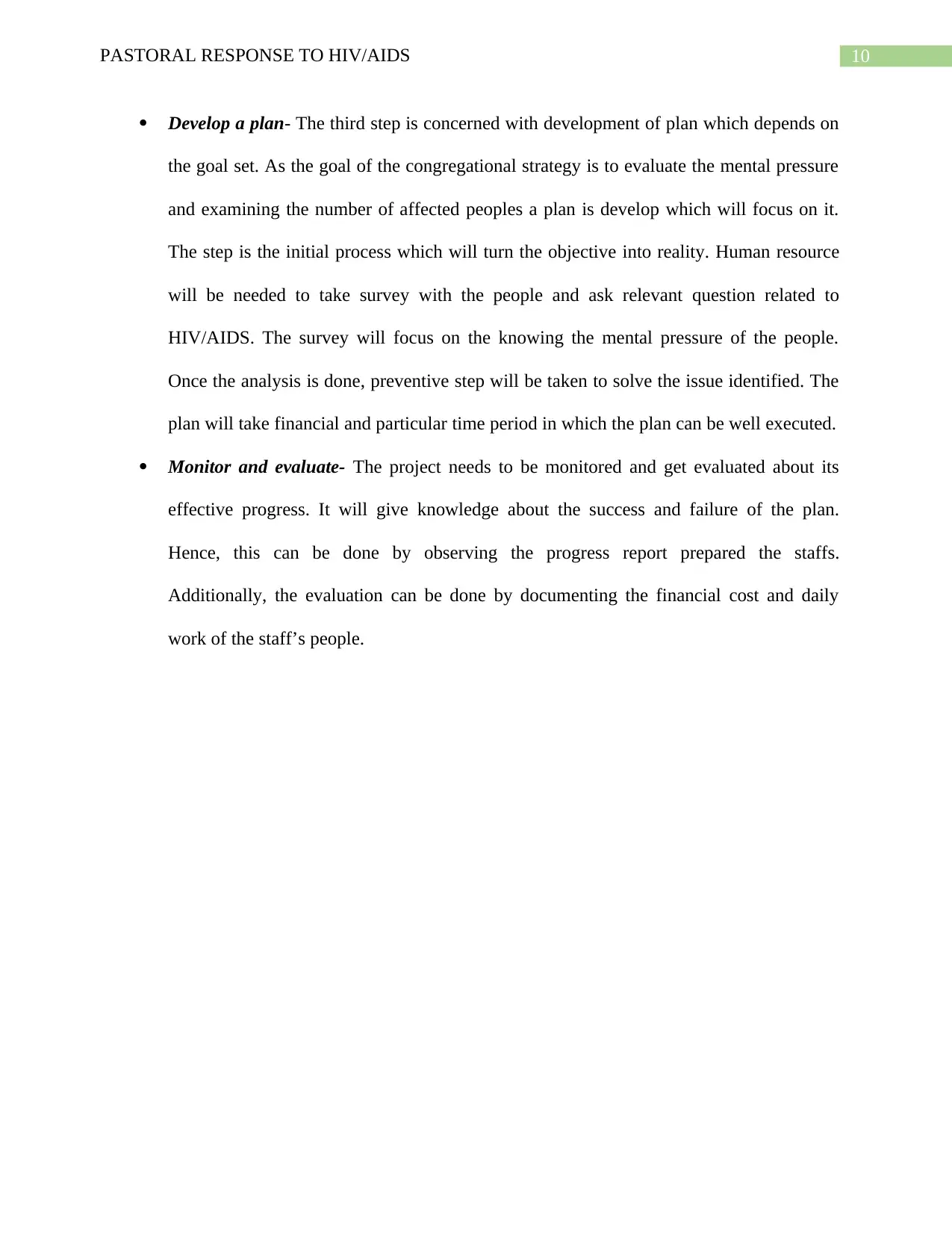
10PASTORAL RESPONSE TO HIV/AIDS
Develop a plan- The third step is concerned with development of plan which depends on
the goal set. As the goal of the congregational strategy is to evaluate the mental pressure
and examining the number of affected peoples a plan is develop which will focus on it.
The step is the initial process which will turn the objective into reality. Human resource
will be needed to take survey with the people and ask relevant question related to
HIV/AIDS. The survey will focus on the knowing the mental pressure of the people.
Once the analysis is done, preventive step will be taken to solve the issue identified. The
plan will take financial and particular time period in which the plan can be well executed.
Monitor and evaluate- The project needs to be monitored and get evaluated about its
effective progress. It will give knowledge about the success and failure of the plan.
Hence, this can be done by observing the progress report prepared the staffs.
Additionally, the evaluation can be done by documenting the financial cost and daily
work of the staff’s people.
Develop a plan- The third step is concerned with development of plan which depends on
the goal set. As the goal of the congregational strategy is to evaluate the mental pressure
and examining the number of affected peoples a plan is develop which will focus on it.
The step is the initial process which will turn the objective into reality. Human resource
will be needed to take survey with the people and ask relevant question related to
HIV/AIDS. The survey will focus on the knowing the mental pressure of the people.
Once the analysis is done, preventive step will be taken to solve the issue identified. The
plan will take financial and particular time period in which the plan can be well executed.
Monitor and evaluate- The project needs to be monitored and get evaluated about its
effective progress. It will give knowledge about the success and failure of the plan.
Hence, this can be done by observing the progress report prepared the staffs.
Additionally, the evaluation can be done by documenting the financial cost and daily
work of the staff’s people.
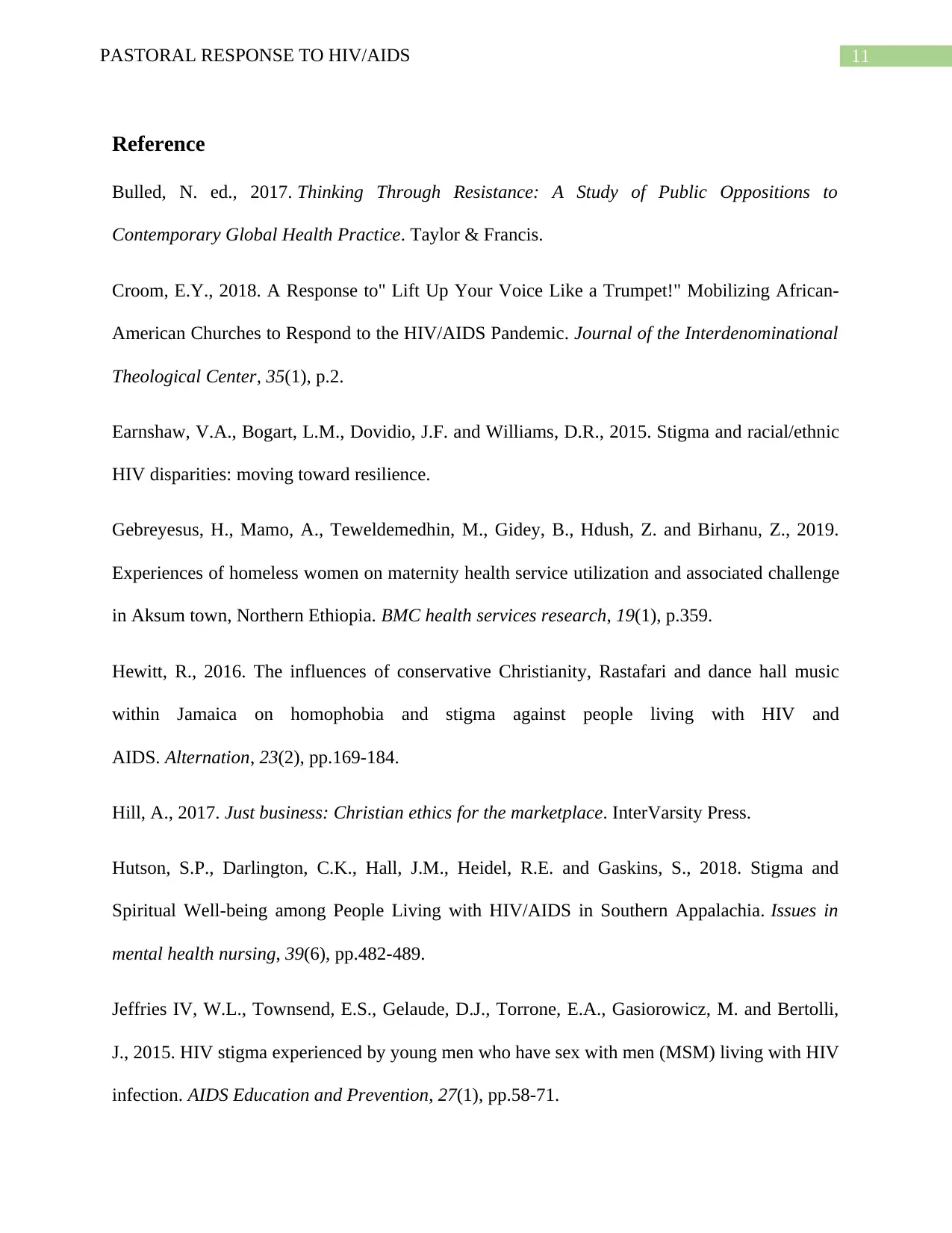
11PASTORAL RESPONSE TO HIV/AIDS
Reference
Bulled, N. ed., 2017. Thinking Through Resistance: A Study of Public Oppositions to
Contemporary Global Health Practice. Taylor & Francis.
Croom, E.Y., 2018. A Response to" Lift Up Your Voice Like a Trumpet!" Mobilizing African-
American Churches to Respond to the HIV/AIDS Pandemic. Journal of the Interdenominational
Theological Center, 35(1), p.2.
Earnshaw, V.A., Bogart, L.M., Dovidio, J.F. and Williams, D.R., 2015. Stigma and racial/ethnic
HIV disparities: moving toward resilience.
Gebreyesus, H., Mamo, A., Teweldemedhin, M., Gidey, B., Hdush, Z. and Birhanu, Z., 2019.
Experiences of homeless women on maternity health service utilization and associated challenge
in Aksum town, Northern Ethiopia. BMC health services research, 19(1), p.359.
Hewitt, R., 2016. The influences of conservative Christianity, Rastafari and dance hall music
within Jamaica on homophobia and stigma against people living with HIV and
AIDS. Alternation, 23(2), pp.169-184.
Hill, A., 2017. Just business: Christian ethics for the marketplace. InterVarsity Press.
Hutson, S.P., Darlington, C.K., Hall, J.M., Heidel, R.E. and Gaskins, S., 2018. Stigma and
Spiritual Well-being among People Living with HIV/AIDS in Southern Appalachia. Issues in
mental health nursing, 39(6), pp.482-489.
Jeffries IV, W.L., Townsend, E.S., Gelaude, D.J., Torrone, E.A., Gasiorowicz, M. and Bertolli,
J., 2015. HIV stigma experienced by young men who have sex with men (MSM) living with HIV
infection. AIDS Education and Prevention, 27(1), pp.58-71.
Reference
Bulled, N. ed., 2017. Thinking Through Resistance: A Study of Public Oppositions to
Contemporary Global Health Practice. Taylor & Francis.
Croom, E.Y., 2018. A Response to" Lift Up Your Voice Like a Trumpet!" Mobilizing African-
American Churches to Respond to the HIV/AIDS Pandemic. Journal of the Interdenominational
Theological Center, 35(1), p.2.
Earnshaw, V.A., Bogart, L.M., Dovidio, J.F. and Williams, D.R., 2015. Stigma and racial/ethnic
HIV disparities: moving toward resilience.
Gebreyesus, H., Mamo, A., Teweldemedhin, M., Gidey, B., Hdush, Z. and Birhanu, Z., 2019.
Experiences of homeless women on maternity health service utilization and associated challenge
in Aksum town, Northern Ethiopia. BMC health services research, 19(1), p.359.
Hewitt, R., 2016. The influences of conservative Christianity, Rastafari and dance hall music
within Jamaica on homophobia and stigma against people living with HIV and
AIDS. Alternation, 23(2), pp.169-184.
Hill, A., 2017. Just business: Christian ethics for the marketplace. InterVarsity Press.
Hutson, S.P., Darlington, C.K., Hall, J.M., Heidel, R.E. and Gaskins, S., 2018. Stigma and
Spiritual Well-being among People Living with HIV/AIDS in Southern Appalachia. Issues in
mental health nursing, 39(6), pp.482-489.
Jeffries IV, W.L., Townsend, E.S., Gelaude, D.J., Torrone, E.A., Gasiorowicz, M. and Bertolli,
J., 2015. HIV stigma experienced by young men who have sex with men (MSM) living with HIV
infection. AIDS Education and Prevention, 27(1), pp.58-71.
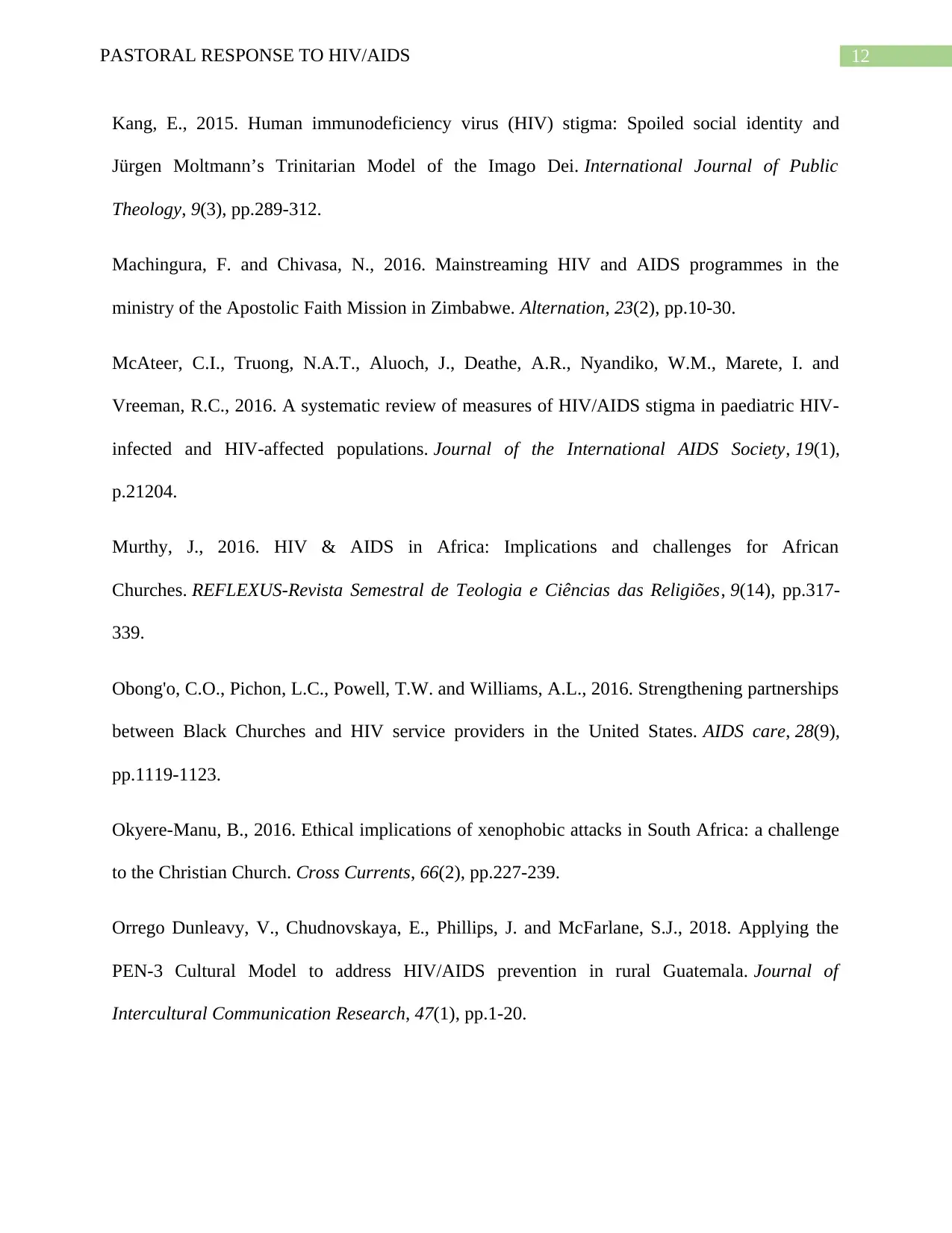
12PASTORAL RESPONSE TO HIV/AIDS
Kang, E., 2015. Human immunodeficiency virus (HIV) stigma: Spoiled social identity and
Jürgen Moltmann’s Trinitarian Model of the Imago Dei. International Journal of Public
Theology, 9(3), pp.289-312.
Machingura, F. and Chivasa, N., 2016. Mainstreaming HIV and AIDS programmes in the
ministry of the Apostolic Faith Mission in Zimbabwe. Alternation, 23(2), pp.10-30.
McAteer, C.I., Truong, N.A.T., Aluoch, J., Deathe, A.R., Nyandiko, W.M., Marete, I. and
Vreeman, R.C., 2016. A systematic review of measures of HIV/AIDS stigma in paediatric HIV‐
infected and HIV‐affected populations. Journal of the International AIDS Society, 19(1),
p.21204.
Murthy, J., 2016. HIV & AIDS in Africa: Implications and challenges for African
Churches. REFLEXUS-Revista Semestral de Teologia e Ciências das Religiões, 9(14), pp.317-
339.
Obong'o, C.O., Pichon, L.C., Powell, T.W. and Williams, A.L., 2016. Strengthening partnerships
between Black Churches and HIV service providers in the United States. AIDS care, 28(9),
pp.1119-1123.
Okyere-Manu, B., 2016. Ethical implications of xenophobic attacks in South Africa: a challenge
to the Christian Church. Cross Currents, 66(2), pp.227-239.
Orrego Dunleavy, V., Chudnovskaya, E., Phillips, J. and McFarlane, S.J., 2018. Applying the
PEN-3 Cultural Model to address HIV/AIDS prevention in rural Guatemala. Journal of
Intercultural Communication Research, 47(1), pp.1-20.
Kang, E., 2015. Human immunodeficiency virus (HIV) stigma: Spoiled social identity and
Jürgen Moltmann’s Trinitarian Model of the Imago Dei. International Journal of Public
Theology, 9(3), pp.289-312.
Machingura, F. and Chivasa, N., 2016. Mainstreaming HIV and AIDS programmes in the
ministry of the Apostolic Faith Mission in Zimbabwe. Alternation, 23(2), pp.10-30.
McAteer, C.I., Truong, N.A.T., Aluoch, J., Deathe, A.R., Nyandiko, W.M., Marete, I. and
Vreeman, R.C., 2016. A systematic review of measures of HIV/AIDS stigma in paediatric HIV‐
infected and HIV‐affected populations. Journal of the International AIDS Society, 19(1),
p.21204.
Murthy, J., 2016. HIV & AIDS in Africa: Implications and challenges for African
Churches. REFLEXUS-Revista Semestral de Teologia e Ciências das Religiões, 9(14), pp.317-
339.
Obong'o, C.O., Pichon, L.C., Powell, T.W. and Williams, A.L., 2016. Strengthening partnerships
between Black Churches and HIV service providers in the United States. AIDS care, 28(9),
pp.1119-1123.
Okyere-Manu, B., 2016. Ethical implications of xenophobic attacks in South Africa: a challenge
to the Christian Church. Cross Currents, 66(2), pp.227-239.
Orrego Dunleavy, V., Chudnovskaya, E., Phillips, J. and McFarlane, S.J., 2018. Applying the
PEN-3 Cultural Model to address HIV/AIDS prevention in rural Guatemala. Journal of
Intercultural Communication Research, 47(1), pp.1-20.
Paraphrase This Document
Need a fresh take? Get an instant paraphrase of this document with our AI Paraphraser
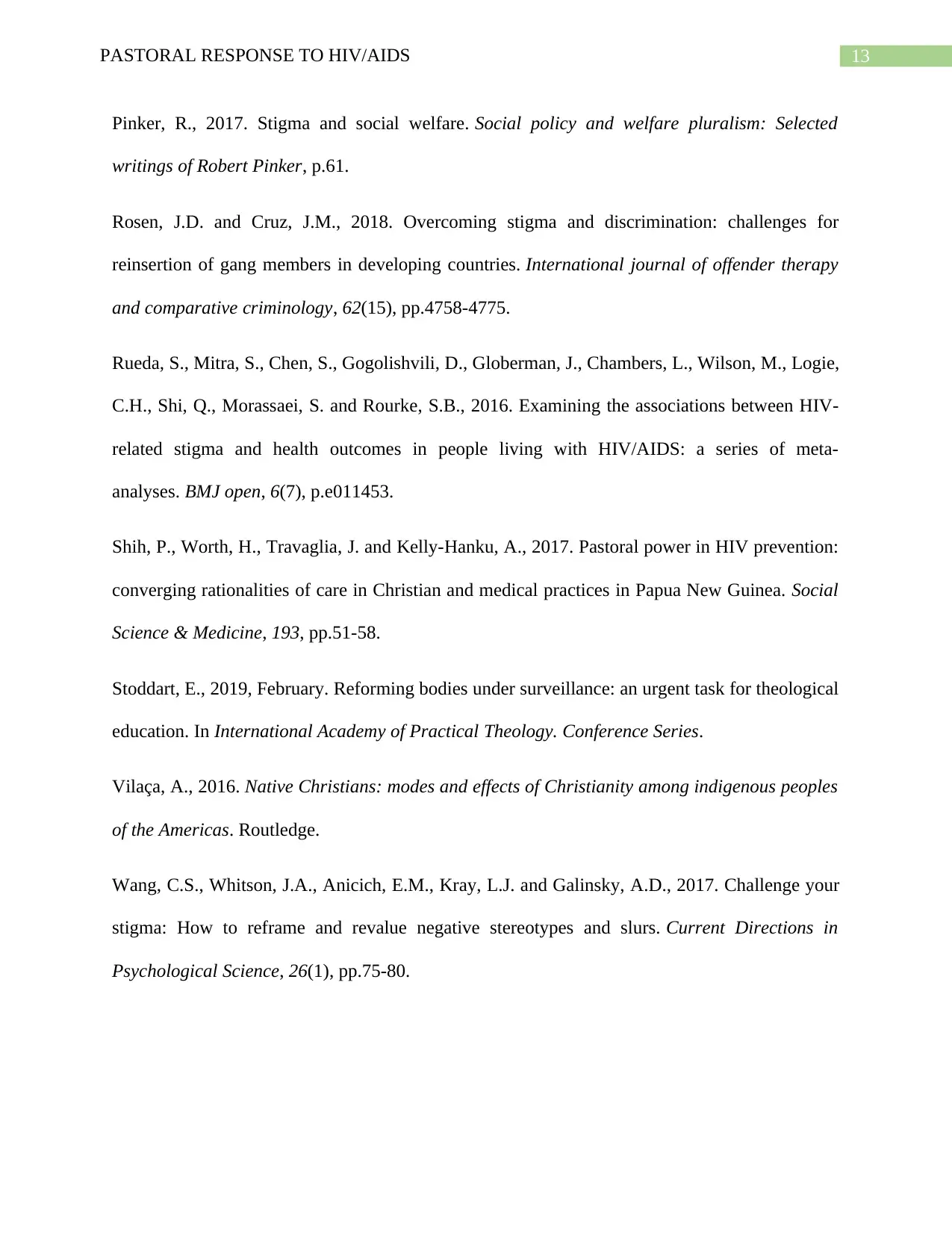
13PASTORAL RESPONSE TO HIV/AIDS
Pinker, R., 2017. Stigma and social welfare. Social policy and welfare pluralism: Selected
writings of Robert Pinker, p.61.
Rosen, J.D. and Cruz, J.M., 2018. Overcoming stigma and discrimination: challenges for
reinsertion of gang members in developing countries. International journal of offender therapy
and comparative criminology, 62(15), pp.4758-4775.
Rueda, S., Mitra, S., Chen, S., Gogolishvili, D., Globerman, J., Chambers, L., Wilson, M., Logie,
C.H., Shi, Q., Morassaei, S. and Rourke, S.B., 2016. Examining the associations between HIV-
related stigma and health outcomes in people living with HIV/AIDS: a series of meta-
analyses. BMJ open, 6(7), p.e011453.
Shih, P., Worth, H., Travaglia, J. and Kelly-Hanku, A., 2017. Pastoral power in HIV prevention:
converging rationalities of care in Christian and medical practices in Papua New Guinea. Social
Science & Medicine, 193, pp.51-58.
Stoddart, E., 2019, February. Reforming bodies under surveillance: an urgent task for theological
education. In International Academy of Practical Theology. Conference Series.
Vilaça, A., 2016. Native Christians: modes and effects of Christianity among indigenous peoples
of the Americas. Routledge.
Wang, C.S., Whitson, J.A., Anicich, E.M., Kray, L.J. and Galinsky, A.D., 2017. Challenge your
stigma: How to reframe and revalue negative stereotypes and slurs. Current Directions in
Psychological Science, 26(1), pp.75-80.
Pinker, R., 2017. Stigma and social welfare. Social policy and welfare pluralism: Selected
writings of Robert Pinker, p.61.
Rosen, J.D. and Cruz, J.M., 2018. Overcoming stigma and discrimination: challenges for
reinsertion of gang members in developing countries. International journal of offender therapy
and comparative criminology, 62(15), pp.4758-4775.
Rueda, S., Mitra, S., Chen, S., Gogolishvili, D., Globerman, J., Chambers, L., Wilson, M., Logie,
C.H., Shi, Q., Morassaei, S. and Rourke, S.B., 2016. Examining the associations between HIV-
related stigma and health outcomes in people living with HIV/AIDS: a series of meta-
analyses. BMJ open, 6(7), p.e011453.
Shih, P., Worth, H., Travaglia, J. and Kelly-Hanku, A., 2017. Pastoral power in HIV prevention:
converging rationalities of care in Christian and medical practices in Papua New Guinea. Social
Science & Medicine, 193, pp.51-58.
Stoddart, E., 2019, February. Reforming bodies under surveillance: an urgent task for theological
education. In International Academy of Practical Theology. Conference Series.
Vilaça, A., 2016. Native Christians: modes and effects of Christianity among indigenous peoples
of the Americas. Routledge.
Wang, C.S., Whitson, J.A., Anicich, E.M., Kray, L.J. and Galinsky, A.D., 2017. Challenge your
stigma: How to reframe and revalue negative stereotypes and slurs. Current Directions in
Psychological Science, 26(1), pp.75-80.

14PASTORAL RESPONSE TO HIV/AIDS
1 out of 15
Related Documents
Your All-in-One AI-Powered Toolkit for Academic Success.
+13062052269
info@desklib.com
Available 24*7 on WhatsApp / Email
![[object Object]](/_next/static/media/star-bottom.7253800d.svg)
Unlock your academic potential
© 2024 | Zucol Services PVT LTD | All rights reserved.




